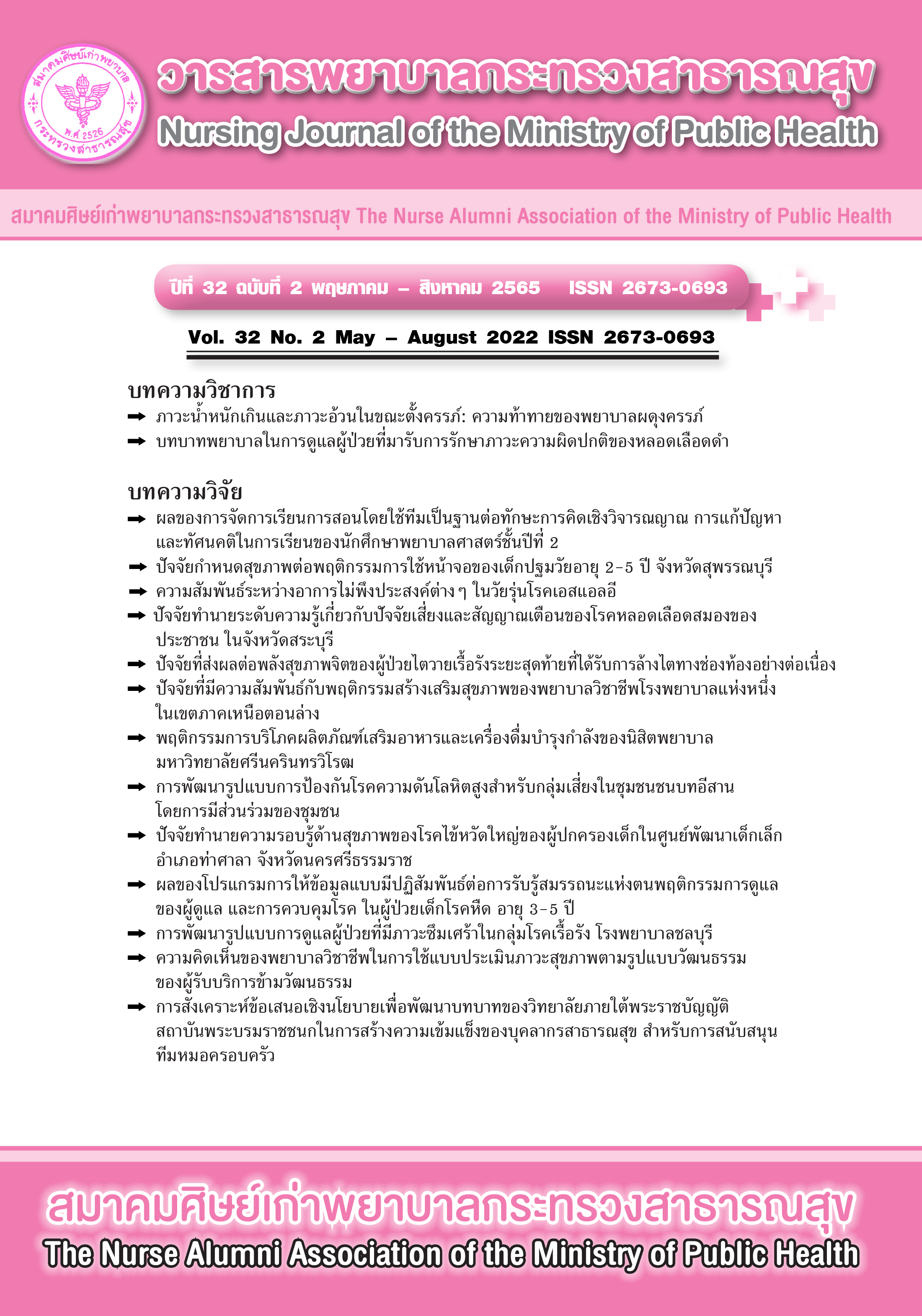Roles of Nurses in Caring for Patients Receiving Venous Malformation Treatment
Main Article Content
Abstract
Venous malformations can occur in childhood and adolescence. Common presenting symptoms include pain and cosmetic problems with scarring, especially when the lesions occur over the head and neck regions. These can affect social appearance leading to anxiety of the patients and their parents. Until now, surgical treatment has been limited to small and superficial lesions. If the lesions are large or deep, other appropriate treatment may be considered, such as medication or radiation therapy. Currently, sclerotherapy, an alternative interventional radiology treatment, is performed for these patients with good outcomes. However, this particular treatment involves advanced and complex technology that can only be performed by medical specialists. Nurses must therefore acquire new knowledge and skills relevant to the care of patients undergoing this kind of treatment. This purpose of this article is to provide clinical information about venous malformations and the role of nurses in the care of these patients, including pretreatment, during treatment and posttreatment. This information could be used to guide nurses in providing care for patients based on evidence-based practice leading to patient safety and family satisfaction.
Article Details

This work is licensed under a Creative Commons Attribution-NonCommercial-NoDerivatives 4.0 International License.
บทความและรายงานวิจัยในวารสารพยาบาลกระทรวงสาธารณสุข เป็นความคิดเห็นของ ผู้เขียน มิใช่ของคณะผู้จัดทำ และมิใช่ความรับผิดชอบของสมาคมศิษย์เก่าพยาบาลกระทรวงสาธารณสุข ซึ่งสามารถนำไปอ้างอิงได้
References
Nguyen D, Towbin R, Schaefer CM, Towbin AJ, Aria DJ. Alexander J. Congenital venous malformation. Appl Radiol.2021;50(6):11-5
Dasgupta R, Fishman SJ. ISSVA classification. Semin Pediatr Surg 2014;23:158-61.
Ali S, Weiss CR, Sinha A, Eng J, Mitchell SE. The treatment of venous malformations with percutaneous sclerotherapy at a single academic medical center. Phlebology 2016;31:603-9.
Songsaeng D, Churojana A, Khumthong R, Mahiwan L. Comparative outcomes for sclerotherapy of head and neck venous vascular malformation between alcohol and bleomycin. J Med Assoc Thai. 2015 Apr;98(4):408-13.
Seront E, Vikkula M, Boon LM. Venous malformations of the head and neck. Otolaryngol Clin North Am 2018;51:173-84.
Carqueja IM, Sousa J, Mansilha, A. Vascular malformations: Classification, diagnosis and treatment. Int. Angiol.2018;37:127–42.
Aga H, Burke GAE, Nishikawa H, Monaghan A. The Birmingham algorithm for the diagnosis and management of vascular malformations. Br J Oral Maxillofac Surg 2012;50(suppl): 1. doi: https://doi.org/10.1016/j. bjoms.2012.04.101.
Behravesh S, Yakes W, Gupta N, Naidu S, Chong BW, Khademhosseini A, et al. Venous malformations: clinical diagnosis and treatment. Cardiovasc Diagn Ther.2016;6(6):557-69.
Orlando JL, Caldas JG, Campos HG, Nishinari K, Krutman M, Wolosker N. Ethanol sclerotherapy of head and neck venous malformations. Einstein (Sao Paulo).2014;12(2):181-6.
Lee H, Kim T, Kim JM, Kim GW, Ko H, Kim BS, Kim MB, Kim HS. Percutaneous sclerotherapy using bleomycin for the treatment of vascular malformations. Int J Dermatol 2017;56:1186–1191. doi:10.1111/ijd.13733.
Redkar RG, Chigicherla S, Joshi S, Bangar A, Tewari S. Efficacy of intralesional bleomycin as an alternative approach in the management of vascular anomalies. Saudi Surg J 2017;5(2):60-64.
Horbach SE, Rigter IM, Smitt JH, Reekers JA, Spuls Pl, van der Horst CM. Intralesional bleomycin injections for vascular malformations: a systematic review and meta-analysis. Plast Reconstr Surg 2016;137:244-56.
Hage AN, Chick JFB, Srinivasa RN, et al. Treatment of venous malformations: the data, where we are, and how it is done. Tech Vasc Interv Radiol 2018;21:45-54.
Prayooltem R, Vongwisanupong N, Songwathana PImprovement of discharge planning and continuing care for vascular surgery patients: a case study. Thai Journal of Nursing Council 2019;34(2):5-17.
Zhang X, Zhao X, Wu P, Zhao Z, Liu M, Wang Y. Prevalence and associated factors of anxiety and depression among patients with oromaxillofacial venous malformations. Ann Palliat Med 2021;10(8):8642-50.doi:10.21037/apm-21-608.

